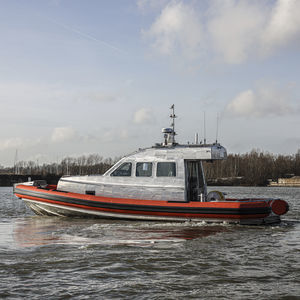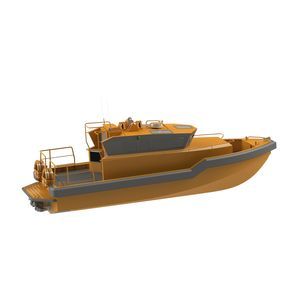
- Ships and professional boats
- Service and Work boats
- Rescue boat
- HABBEKE SHIPYARD
Rescue boat FRC 1405outboardaluminumrigid hull inflatable boat
Add to favorites
Compare this product
Characteristics
- Type
- rescue boat
- Motor type
- outboard
- Material
- aluminum
- Other characteristics
- rigid hull inflatable boat
- Length
13.85 m
(45'05" )- Maximum width
4.55 m
(14'11" )- Draft
0.8 m
(2'07" )- Weight
13 t
(14 us ton)- Motor power
1,700 ch
(1,700 hp)- Cruising speed
40 kt
- Passenger capacity
6 unit
- Fuel capacity
1,350 l
(357 gal)
Description
While the volunteers of the “Vrijwillige Blankenbergse Zeereddingsdienst” (VBZR) are very satisfied with their current largest SAR vessels, STRAFFE HENDRIK & STERKEN DRIES, there are undeniably points for improvement on these designs
The working area of the VBZR extends from the Dutch coast at Cadzand to the Belgian city Ostend. Rescue operations outside the 5‑mile zone also fall within the scope of the VBZR
The main goals for their new design where to reduce vertical acceleration, noise, fuel consumption and emissions, improve towing capabilities, comfort and safety of those on board
VBZR presented a concept for the new lifeboat, this concept was the base of which Habbeké Shipyard’s Naval Architect Pieter Meuzelaar started to design the Fast Rescue Craft (FRC) © 1405
The hull lines are based on her smaller sister, the FRC©903 SD, with deep‑V to ensure good seakeeping capabilities and performance. The length of the forefoot is balanced to reduce the risk of broaching in following seas, but also ensure enough reserve buoyancy in case of bow-diving
The fully enclosed wheelhouse gives maximum comfort to the crew and allows to accommodate an injured person on a stretcher. But when the large pantograph door is open it gives the benefits of an open Lifeboat. The coxswains position is so that he has an unobstructed view all around
Essential for manoeuvrability, shallow-water operations and the safe recovery of persons at the stern, propulsion with waterjets was a given from the start. On the FRC © 1405, each Kamewa FF375S waterjet is powered by a MAN i6 main engine, good for 850 bhp each, so a whopping total of 1700 bhp, which propel the boat to a maximum speed of 40 knots
Catalogs
No catalogs are available for this product.
See all of HABBEKE SHIPYARD‘s catalogsRelated Searches
- Professional boat
- Inboard professional boat
- Aluminum professional boat
- Outboard professional boat
- Patrol boat
- Passenger boat
- Rescue boat
- Work boat
- Diesel professional boat
- Harbor service boat
- Dive support boat
- Pilot boat
- Electro solar professional boat
- Crew boat
- Offshore service boat
- Search and rescue boat
- RIB professional boat
- Trailerable professional boat
- Self-righting professional boat
- Water taxi
*Prices are pre-tax. They exclude delivery charges and customs duties and do not include additional charges for installation or activation options. Prices are indicative only and may vary by country, with changes to the cost of raw materials and exchange rates.














